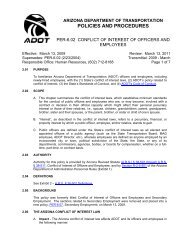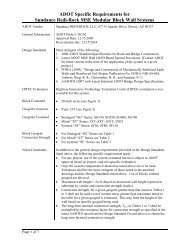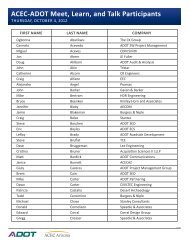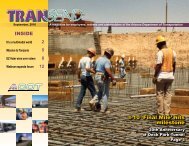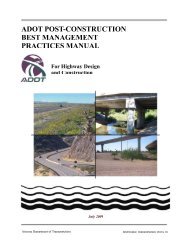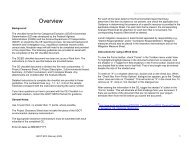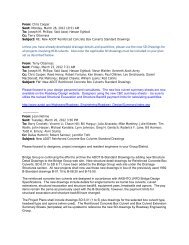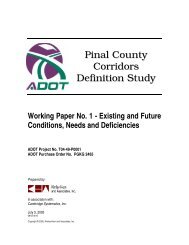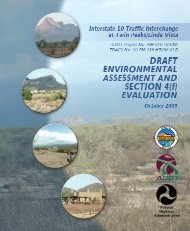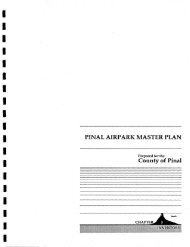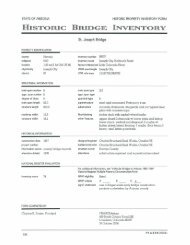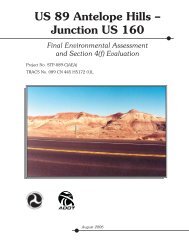ADOT Editorial Style Guide - Arizona Department of Transportation
ADOT Editorial Style Guide - Arizona Department of Transportation
ADOT Editorial Style Guide - Arizona Department of Transportation
You also want an ePaper? Increase the reach of your titles
YUMPU automatically turns print PDFs into web optimized ePapers that Google loves.
4. <strong>Editorial</strong> <strong>Style</strong> <strong>Guide</strong> | Punctuation Review<br />
Parentheses, ( )<br />
parenthetical information. Use sparingly. In general, rewrite the sentence so that the information does not have to be set <strong>of</strong>f with<br />
parentheses.<br />
with periods. Place a period outside a closing parenthesis if the material inside is not a sentence (such as this fragment). (An<br />
independent parenthetical sentence like this one takes a period before the closing parenthesis.) When a clause placed in<br />
parentheses (this one is an example) might normally qualify as a complete sentence but is dependent on the surrounding material, do<br />
not capitalize the first word or end with a period.<br />
Periods, .<br />
sentence termination. Use a period to end declarative and mildly imperative sentences: The stylebook is finished. Shut the book. Use<br />
an exclamation point if greater emphasis is desired for imperative sentences: Be careful! Use a period to end rhetorical and indirect<br />
questions: Why don’t we go. He asked what the score was.SPACING. Use a single space after a period at the end <strong>of</strong> a sentence.<br />
abbreviations. Most lowercase and two-letter uppercase abbreviations take periods. Check individual entries and Merriam-Webster for<br />
specific abbreviations.<br />
initials. One- and two-letter initials take periods: John F. Kennedy, T.S. Eliot. No spaces between two-letter initials. Abbreviations using<br />
only the initials <strong>of</strong> a name do not take periods: JFK, LBJ.<br />
placement with quotation marks. Periods always go inside quotation marks.<br />
Question Marks, ?<br />
sentence termination. Use a question mark to end direct and interpolated questions: When will the on-ramp close? You told me —<br />
Did I hear you correctly? — that the on-ramp would be closed all weekend.<br />
placement with quotation marks. Place within quotation marks when part <strong>of</strong> the quoted text only: Who wrote “Gone with the Wind”?<br />
He asked, “How long is the book?”<br />
miscellaneous. The question mark supersedes the comma that normally is used when supplying attribution for a quotation: “How long<br />
is the book?” he asked.<br />
Quotation Marks, “ ”<br />
when not required. Original text and Q-and-A formats.<br />
irony. Put quotation marks around a word or words used in an ironical sense: The “debate” turned into a free-for-all.<br />
unfamiliar terms. A word or words being introduced to readers may be placed in quotation marks on first reference and then eschewed<br />
in subsequent references: Broadcast frequencies are measured in “kilohertz.”<br />
composition titles. Put quotation marks around all titles except religious texts and books that are primarily catalogs <strong>of</strong> reference<br />
material, including almanacs, directories, dictionaries, encyclopedias, gazetteers, handbooks and similar productions: the Talmud, “The<br />
Late Night Show with Jay Leno,” “The Hunger Games,” the Farmer’s Almanac. Do not use quotation marks around titles <strong>of</strong> s<strong>of</strong>tware:<br />
Windows, WordPerfect.<br />
quotations within quotations. Alternate between double quotation marks (“ or ”) and single quotation marks (‘ or ’). Use three marks<br />
together if two quoted elements end at the same time: She said, “He told me, ‘I’m a big fan.’”<br />
<strong>ADOT</strong> <strong>Guide</strong> to editorial standards



